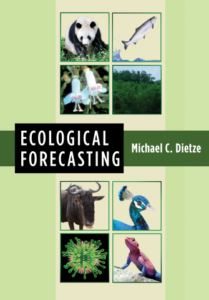
Ecologists are being asked to respond to unprecedented environmental challenges. How can they provide the best available scientific information about what will happen in the future? Ecological Forecasting by Michael Dietze is the first book to bring together the concepts and tools needed to make ecology a more predictive science.
Ecological Forecasting presents a new way of doing ecology. A closer connection between data and models can help us to project our current understanding of ecological processes into new places and times. This accessible and comprehensive book covers a wealth of topics, including Bayesian calibration and the complexities of real-world data; uncertainty quantification, partitioning, propagation, and analysis; feedbacks from models to measurements; state-space models and data fusion; iterative forecasting and the forecast cycle; and decision support.
Hands-on Activities
Hands-on material (code, tutorials, etc.) related to learning the skills of ecological forecasting, ecoinformatics, and data assimilation are available through the EcoForecast GitHub Repository.
Specifically, activities developed in conjunction with the Ecological Forecasting book are in the EF_Activities repository.
Book Contents

- Introduction
- From Models to Forecasts
- Data, Large and Small
- Scientific Workflows and the Informatics of Model-Data Fusion
- Introduction to Bayes
- Characterizing Uncertainty
- Case Study: Biodiversity, Populations, and Endangered Species
- Latent Variables and State-Space Models
- Fusing Data Sources
- Case Study: Natural Resources
- Propagating, Analyzing, and Reducing Uncertainty
- Case Study: Carbon Cycle
- Data Assimilation 1: Analytical Methods
- Data Assimilation 2: Monte Carlo Methods
- Case Study: Epidemiology
- Assessing Model Performance
- Projection and Decision Support
- Final Thoughts
Endorsements
“As the world enters an era of change in which the past is a limited guide to the future, one great challenge is predicting how ecosystems will behave in situations for which there is no analog. While many scientists have recognized this problem, Dietze has done something about it, and mobilized a set of concepts and tools to draw on. He synthesizes a wide range of information and makes some genuinely difficult material accessible. This book really has no competitors.”–David Schimel, author of Climate and Ecosystems
“We’d all be better off if we could forecast the future state of complex systems such as the weather, our health, and the stock market. Dietze shows us how to approach forecasting using models based on large datasets and how to make the results easy to digest. This book is certain to be a benchmark in the science of ecological forecasting for decades to come.”–William H. Schlesinger, president emeritus of the Cary Institute of Ecosystem Studies
“Dietze’s subject is a really important one, and his focus on forecasting and its implementation is novel.”–Alan Hastings, University of California, Davis
“Using clear and elegant language, Dietze describes the statistical, informatics, and model-data fusion techniques necessary for forecasting—techniques that move the science of ecology beyond case studies and static models. Quantifying uncertainty, variability, and especially complexity will make ecology the predictive science it must become to solve critical environmental problems.”–Jill Baron, United States Geological Survey
“For ecology to become a more predictive science, Dietze asserts ecologists must more effectively link statistics, modeling, and informatics with their data gathering efforts. His book provides both the conceptual and technical basis for doing just that. It is remarkable for its clarity, accessibility, and interdisciplinary breadth.”–Norm Christensen, coauthor of The Environment and You
Reviews
Basic and Applied Ecology Carsten F. Dormann
Corrections
In Table 11.1 “Taylor Series” should be under Analytical/Moments not Numeric/Moments
Under Eqn 13.6, “… R, and forecast, Pf, precision..” precision should be variance here.
